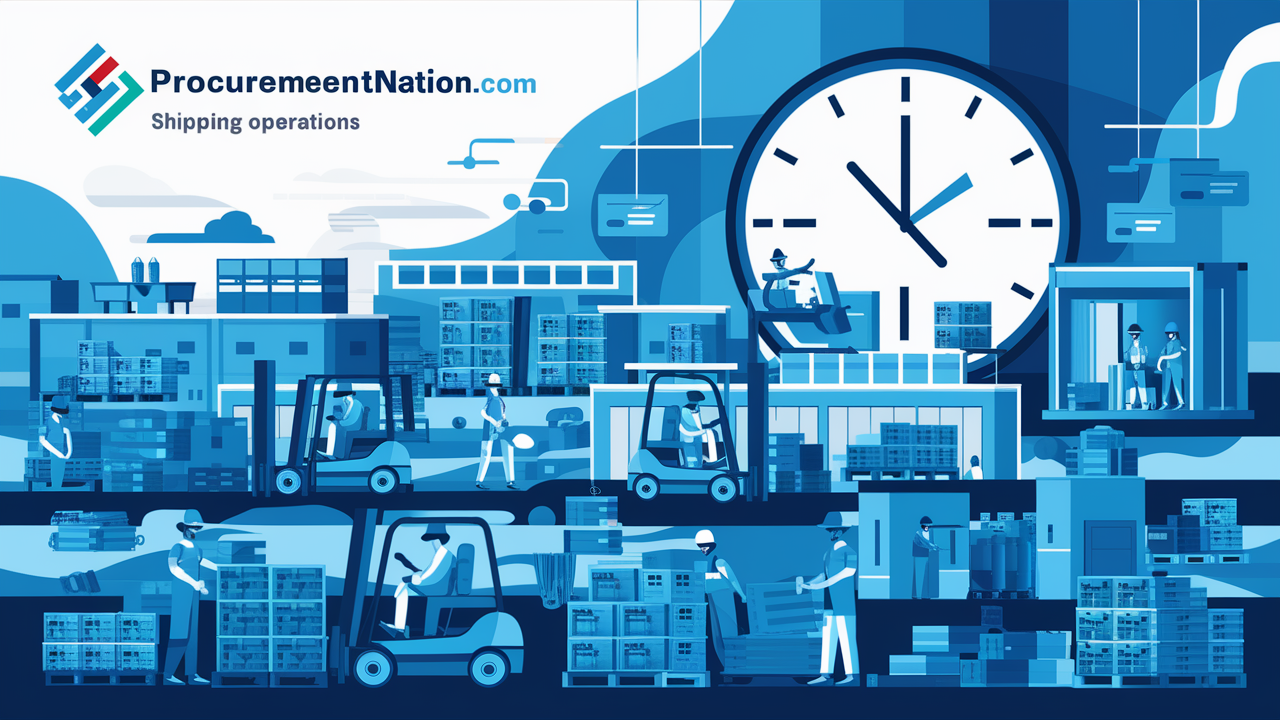ProcurementNation.com Shipping: A Comprehensive Guide

Introduction
In today’s interconnected global economy, efficient shipping and logistics play a critical role in the success of businesses. Whether companies are sourcing raw materials or delivering finished products, seamless procurement and shipping processes ensure competitiveness and sustainability. ProcurementNation.com has emerged as a leading resource in procurement and supply chain management, offering insights and solutions for businesses navigating the complexities of international trade.
Shipping, an integral part of procurement, involves multiple stakeholders, regulations, and logistics challenges. Understanding how ProcurementNation.com provides guidance and strategies for optimizing shipping processes can help businesses reduce costs, enhance supply chain efficiency, and improve overall customer satisfaction. This article explores the importance of procurement shipping, the challenges involved, and the best practices that businesses can adopt to streamline their logistics operations.
The Importance of Procurement Shipping in Global Trade
Shipping is more than just transporting goods from one place to another—it is a fundamental component of the procurement process that affects costs, timelines, and customer relationships. Businesses that rely on global suppliers must ensure that their shipping methods align with their procurement goals to maintain a steady supply chain.
The impact of procurement shipping can be seen in various aspects of business operations. Efficient shipping reduces lead times, ensuring that manufacturers receive raw materials promptly and retailers have sufficient inventory to meet customer demand. Additionally, cost-effective shipping strategies allow businesses to remain competitive by lowering expenses related to warehousing and transportation.
Procurement shipping also plays a crucial role in sustainability. Many companies are now prioritizing eco-friendly shipping methods, such as optimizing routes to reduce fuel consumption and using biodegradable packaging materials. By integrating sustainable practices into procurement shipping, businesses can contribute to environmental conservation while enhancing their corporate social responsibility initiatives.
Challenges in Procurement Shipping and How to Overcome Them
Shipping in procurement involves several challenges that businesses must address to ensure smooth operations. Some of the most common issues include:
1. Delays in Shipping and Delivery
One of the biggest concerns in procurement shipping is delayed deliveries. These can be caused by factors such as customs clearance issues, port congestion, bad weather, or inefficient logistics planning. Delays can disrupt the supply chain, leading to production slowdowns, increased costs, and customer dissatisfaction.
To mitigate delays, businesses should implement proactive strategies, such as working with reliable logistics partners, leveraging real-time tracking technologies, and maintaining buffer stock to absorb unexpected disruptions. Additionally, understanding the regulatory requirements of different countries can help businesses streamline customs processes and avoid unnecessary hold-ups.
2. High Shipping Costs and Budget Constraints
Shipping expenses can significantly impact a company’s bottom line, especially when dealing with international procurement. Fluctuating fuel prices, tariffs, and additional handling charges can make shipping costs unpredictable.
To optimize shipping costs, businesses should explore bulk shipping options, negotiate better rates with freight carriers, and adopt technology-driven logistics solutions that enhance efficiency. Consolidating shipments and choosing cost-effective transportation modes, such as sea freight over air freight, can also help reduce expenses.
3. Supply Chain Disruptions and Logistics Risks
Unforeseen events, such as pandemics, geopolitical tensions, and natural disasters, can disrupt supply chains and create shipping bottlenecks. These disruptions can result in delayed shipments, increased costs, and inventory shortages.
To build a resilient procurement shipping strategy, businesses should diversify their supplier base, adopt a multi-modal shipping approach, and invest in supply chain risk management. Digital tools, such as predictive analytics and AI-powered logistics planning, can help businesses anticipate potential risks and implement contingency plans.
4. Compliance and Regulatory Challenges
Navigating international shipping regulations can be complex, as different countries have varying customs laws, tariffs, and trade restrictions. Non-compliance with these regulations can lead to shipment delays, penalties, or even confiscation of goods.
To ensure compliance, businesses should stay updated on international trade regulations, work with customs brokers or freight forwarders, and leverage digital documentation systems to facilitate smooth clearance. Having a dedicated compliance team can also help businesses navigate the complexities of global shipping regulations.
Best Practices for Streamlining Procurement Shipping
Implementing best practices in procurement shipping can significantly improve supply chain efficiency and reduce operational costs. Here are some effective strategies:

1. Implementing Advanced Logistics Technology
Technology plays a crucial role in modern procurement shipping. Businesses can utilize logistics management software, real-time tracking systems, and AI-driven analytics to optimize their shipping processes. These technologies provide valuable insights into shipping performance, helping businesses identify inefficiencies and make data-driven decisions.
2. Choosing the Right Shipping Partners
Selecting reliable shipping partners is essential for ensuring timely and cost-effective deliveries. Businesses should conduct thorough evaluations of logistics providers based on their track record, service quality, and global reach. Establishing long-term partnerships with reputable carriers can also lead to better rates and service agreements.
3. Adopting Just-in-Time (JIT) Shipping Strategies
JIT shipping minimizes inventory costs by delivering goods only when needed. While this approach can reduce storage expenses, it requires precise coordination between suppliers and logistics providers. Implementing JIT shipping strategies can help businesses maintain lean inventory levels while ensuring a continuous supply of materials.
4. Enhancing Warehouse and Inventory Management
Efficient warehouse management complements procurement shipping by reducing handling times and improving order fulfillment. Businesses should invest in automated warehouse systems, such as barcode scanning and robotics, to streamline inventory tracking and minimize errors in shipments.
5. Prioritizing Sustainability in Shipping
Sustainable shipping practices not only reduce environmental impact but also enhance brand reputation. Businesses should explore eco-friendly packaging materials, opt for carbon-neutral shipping options, and collaborate with green logistics providers. Implementing circular supply chain models, where materials are recycled and reused, can further contribute to sustainability efforts.
Future Trends in Procurement Shipping
The shipping industry is continuously evolving, driven by advancements in technology and changing market dynamics. Some emerging trends that are shaping the future of procurement shipping include:
- Automation and Robotics: Automated warehouses and self-driving delivery vehicles are transforming logistics, reducing labor costs, and improving efficiency.
- Blockchain in Supply Chain: Blockchain technology enhances transparency and security in shipping transactions, reducing fraud and improving traceability.
- AI and Predictive Analytics: AI-powered logistics systems provide real-time insights, helping businesses optimize routes and predict demand fluctuations.
- Green Shipping Initiatives: More companies are adopting eco-friendly shipping solutions, such as electric delivery vehicles and alternative fuels, to reduce their carbon footprint.
Frequently Asked Questions (FAQs)
1. What is procurement shipping?
Procurement shipping refers to the transportation of goods as part of the procurement process. It involves selecting carriers, managing logistics, ensuring timely deliveries, and optimizing shipping costs.
2. How can businesses reduce shipping costs in procurement?
Businesses can reduce shipping costs by consolidating shipments, negotiating better rates with carriers, choosing cost-effective transportation modes, and leveraging logistics technology to optimize routes and efficiency.
3. What role does technology play in procurement shipping?
Technology enhances procurement shipping by providing real-time tracking, optimizing logistics operations, reducing errors, and improving overall supply chain visibility. AI, IoT, and blockchain are some of the key technologies driving efficiency in shipping.
4. How can companies ensure sustainability in procurement shipping?
Businesses can adopt sustainable shipping practices by using eco-friendly packaging, optimizing transportation routes to reduce fuel consumption, working with green logistics providers, and implementing circular supply chain models.
5. Why is compliance important in procurement shipping?
Compliance with international shipping regulations ensures smooth customs clearance, prevents legal penalties, and minimizes shipment delays. Businesses should stay informed about trade laws and work with customs experts to navigate regulatory requirements.
Conclusion
Procurement shipping is a vital aspect of supply chain management that directly impacts business efficiency, cost-effectiveness, and customer satisfaction. By addressing challenges such as shipping delays, high costs, and regulatory complexities, businesses can create streamlined and resilient logistics strategies. Leveraging advanced technologies, choosing reliable shipping partners, and adopting sustainable practices will further enhance procurement shipping operations.
As global trade continues to evolve, businesses must stay adaptable and proactive in refining their procurement shipping processes. With insights from ProcurementNation.com, companies can navigate the complexities of global logistics, optimize their supply chains, and achieve long-term success in the competitive market.



